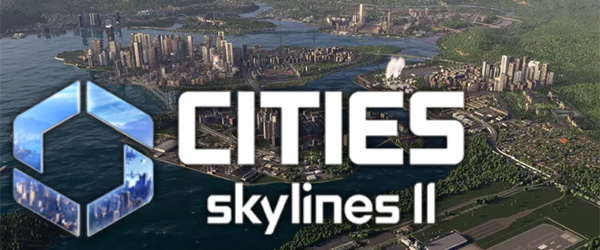
One of the biggest criticisms of Cities Skylines II since its release last fall, has been the lack of expressive options for the player to customize the look and feel of your city. The sequel lacks a lot of the content that was in the first game. But considering that the first game had a 10-year life span, during which it received around a dozen expansions, numerous other content packs, and uncountable mods, it's understandable that the sequel would feel a little lacking in this regard at release. We can't expect a brand new game to have all of the content of such a massively expanded and modded predecessor. That being said, I do think that there are ways that Colossal Order could modify its rules and mechanics in Cities: Skylines II in order to restore some of this expressiveness.
I already published a video and blog outlining my suggestion for a modification to the building upgrade and industry area mechanics in order to make them a lot more flexible and to allow greater freedom for the player to tailor how these assets look and behave. While I was working on that project, I had another idea for how Colossal Order could give players a bit more expressive control over their cities. I had originally planned on briefly sharing this other idea in that first video and blog, but decided to break it out into its own post. I'm not going to transcribe the whole video here on the blog. Instead, I will summarize the main points of the video, and refer you to the full video if you want to see specific examples and more detailed explanation.
Full video outlining my suggestion for adding specialized zoning.
As I mentioned in my previous feature suggestion video for Cities: Skylines II, I have posted a poll on Patreon asking if Patrons would be interested in seeing a "Farewell Tour" video of my Cities: Skylines cities before I uninstall that game for good, and those cities disappear into the ether forever. This poll will close at the end of April. If I get enough interest in such a video, I will plan to begin work on it during the summer.

Remember, my channel is not monetized, and so all of my financial support comes from viewers like you via Patreon. Patreon pledges go towards offsetting the cost of the licenses for the software that I use to create video content like this, as well as the cost of maintaining the blog website at www.MegaBearsFan.net. Patrons receive previews of upcoming content, early access to select content, and voting power in polls of what content I will make next. I would like to take this moment to thank all of my Patrons, past, present, and future. Your support really means a lot. [More]

One of the biggest criticisms of Cities Skylines II is that it is lacking content or feels "incomplete". I don't necessarily disagree, but I feel like saying that the game feels "incomplete" might be doing it a bit of a disservice. It is lacking a lot of content from the original game, sure, but that original game had over a dozen expansions and countless content packs and mod assets released over its decade-long life cycle. So of course there's going to be things that the original, expanded game had, which the new game doesn't have.
But the sequel also has (and does) a lot of things that the original didn't do. It has a much more complicated economy, in which all industries generate specific types of raw materials or goods, and all commercial stores sell specific types of goods or resources. Basically, the core idea of the Industries expansion supply lines and logistics was expanded out to the entire game, rather than just those few specialized industries.
In fact, the sequel includes content or ideas from almost all of the original game's expansions. In addition to the industrial aforementioned seasonal cycle and industrial supply lines, we also have a few natural disasters, some eco-friendly upgrades to various polluting infrastructure, pedestrian roads, road-building tools that put Mass Transit to shame, and some customizable, modular buildings.
Unfortunately, some of these mechanics imported from the original game (and its expansions) do not quite live up to my hopes and expectations. I made a video describing how the modular buildings and industry areas of Cities Skylines II do not live up to the expressiveness and creativity of the Parklife and Industries areas from the first game. I'm not going to transcribe the entire video here. Instead, I will summarize the main points and ideas, and refer you to the full video if you want more detail and examples.
Full video outlining my suggestion for improving building upgrades and industry areas.
Also, I would like to remind my readers and viewers that video and blog content like this is supported by viewers like you through Patreon. So if you like this content, and would like to see more like it, please consider becoming a Patreon for just a dollar or 2 a month. Your patronage helps to offset the cost of maintaining this website, as well as the software licenses I use to create the video content.

Patrons also get previews of and early access to upcoming content, and Patrons at higher tiers have voting power in polls of upcoming projects. I've been working on a massive project about Star Trek video games over the past few months. There are currently a couple previews available on Patreon, and I plan on releasing the entire project early to Patrons when it's finished, while publishing the episodes one at a time to the general public. So if you'd like to see that project early, then consider becoming a Patron. I'd like to take this opportunity to thank all my Patrons, past, present, and future. Your support really means a lot.
[More]
A video retrospective of the last few years' of Cities: Skylines expansions and DLC is on YouTube.
I recently published a new video essay to my YouTube channel about the last few years' worth of expansions and DLC for Cities: Skylines. I will not transcribe the entire essay here, since most of what is in the essay has already been presented in my various reviews of the relevant expansions and DLC. This video features my impressions of the Campus, Sunset Harbor, Airports, Plazas & Promenades, and Hotels " Retreats expansions, as well as the World Tour DLCs (including the Financial Districts mini-DLC and content creator packs).
In summary, while most of these expansions were even more limited in scope than the earlier Cities: Skylines expansions, they started to show some signs that Colossal Order was starting to address some of my long-standing complaints and criticisms with the earlier expansions. Most notably, the newer expansions started to back-port new features and mechanics into the older expansions, such as adding new buildings if players have other expansions installed, or adding new mixed-use transit options that combine transit methods in the new expansions with transit options found in old expansions. It's a lot of subtle stuff, but it goes a long way towards making all the expansions feel more robust and homogenized.
In addition, the newer expansions and content creator packs started introducing assets that I had been asking for for a very long time. These include native parking lots and garages, sports parks such as baseball diamonds and football fields, and new sports stadiums. Sadly, we still don't have public beaches, water parks, or golf courses.
These subtle changes to the way that the expansions also expand other expansions has me very excited and optimistic that Cities: Skylines II will learn lessons from the original game's expansions' faults, and will offer much more robust and complete expansions. [More]
3d066878-8bea-4b2b-9fa2-9e1a9cfbe25f|0|.0
Tags:Cities: Skylines, Cities: Skylines 2, Colossal Order, Paradox Interactive, expansion, Cities: Skylines: Campus, Cities: Skylines: Sunset Harbor, Cities: Skylines: Airports, Cities: Skylines: Plazas and Promenades, Cities: Skylines: Hotels and Retreats, YouTube, Patreon
This week, Colossal Order finally formally announced the anticipated Cities: Skylines 2 and released an official announcement trailer. Unfortunately, the trailer does not have any actual gameplay footage, nor are there any actual in-game screenshots available (that I know of). However, I do want to take some time to go through what is shown in the trailer and make some inferences about what may or may not be in the actual game. Even though the trailer is a pre-rendered cinematic, instead of actual gameplay, we can assume that what is shown in the trailer is intended to represent the actual content of the game -- at least on an abstract level.
First and foremost, here is the trailer itself, in its entirety. I recommend you watch it before reading on.
Cities: Skylines 2 has been formally announced by this trailer.
I will be breaking the trailer down based on 3 criteria. The first is what the narration says, which may provide some hints as to how the game will play. The second is what is actually shown in the trailer. The final category is things that are not included or implied by the trailer.
[More]
cee4240a-11c4-42a4-bfae-e7b10fd50503|0|.0
Tags:Cities: Skylines, Cities: Skylines 2, Colossal Order, Paradox Interactive, city management, trailer, urban decay, waterfront, seasons, parks, traffic, beach, parking, homelessness
Whether you agree with my assertion in the previous essay that NCAA 13's recruiting was better than NCAA 14's, I hope I've at least made a compelling case that NCAA 14's recruiting system left a lot of room for Tiburon to improve in its upcoming EA Sports College Football game in 2023. Now I want to provide some constructive feedback and pitch some ideas I have for how Tiburon could improve the recruiting mechanic going forward, by hopefully taking the best of what both NCAA 13 and 14 had to offer.
This essay is also available in video format on YouTube.
Lessons from NCAA 14
The previous essay included a lot of criticism of NCAA 14, so I want to start off this second part by acknowledging a feature in NCAA 14 that I feel is a strict upgrade over 13, and which I would like to see preserved in EA's future college football games.
I think my single favorite upgrade in NCAA 14 is the idea of having "complimentary" and "competitive campus visits". If you schedule players from complimentary positions to visit campus on the same week, you'll get bonus points. For example, bringing in a running back along with the linemen who will be blocking for him will provide bonus points.
But you also have to be wary of scheduling multiple players of the same position. If you schedule 2 or 3 running backs on the same week, they'll see each other as competition, and will lose interest out of fear that your backfield will be crowded, and they'll loose out on playing time to another back in the same class. This is one of the few elements of 14's recruiting design which I feel retains the more humanistic, character-driven ethos from 13, and I like it a lot.
Users should avoid scheduling multiple recruits at the same position to visit in the same week.
14 also makes it much more clear how your performance on the field will impact the interest level of the visiting prospects. In NCAA 13, I was never clear about whether scheduling a visit during a bye week would make a difference, or if it mattered whether or not I won the game (if I played one that week). I always assumed that the prospect was there to watch the football game, so scheduling the visit during a bye week would impose a penalty, and I also always assumed that winning the game improved the prospect's interest, and I assumed that the prospect would also get more interest if the players at his position performed well during the game. But the U.I. for NCAA 13 was never clear about whether any of that was actually the way the game worked, or if the prospect only cared about the 3 recruiting pitches that I try to sell him on during the visit. NCAA 14 makes all this blatantly clear when you schedule the visit by showing exactly how many points the prospect will get if certain criteria are met. [More]
3f0516a2-bc5c-4199-b08e-5d819e9d1dff|0|.0
Tags:NCAA Football, NCAA Football 13, NCAA Football 14, EA Sports College Football, EA Sports, Tiburon, dynasty, recruiting, ultimate team, loot boxes, gambling, women, gender equality, Sarah Fuller, Katie Hnida, Tonya Butler, Ashley Martin, Liz Heaston, Tony Harris, college football hall of fame, coach, Heather Marini, Katie Sowers, Lori Locust, Jennifer King, sexual harassment, sexual assault
|

| 12 | | | | | | | 60 | | 11 | | | | | | | 55 | | 10 | | | | | | | 50 | | 09 | | | | | | | 45 | | 08 | | | | | | | 40 | | 07 | | | | | | | 35 | | 06 | | | | | | | 30 | | 05 | | | | | | | 25 | | 04 | | | | | | | 20 | | 03 | | | | | | | 15 | | 02 | | | | | | | 10 | | 01 | | | | | | | 05 |
|